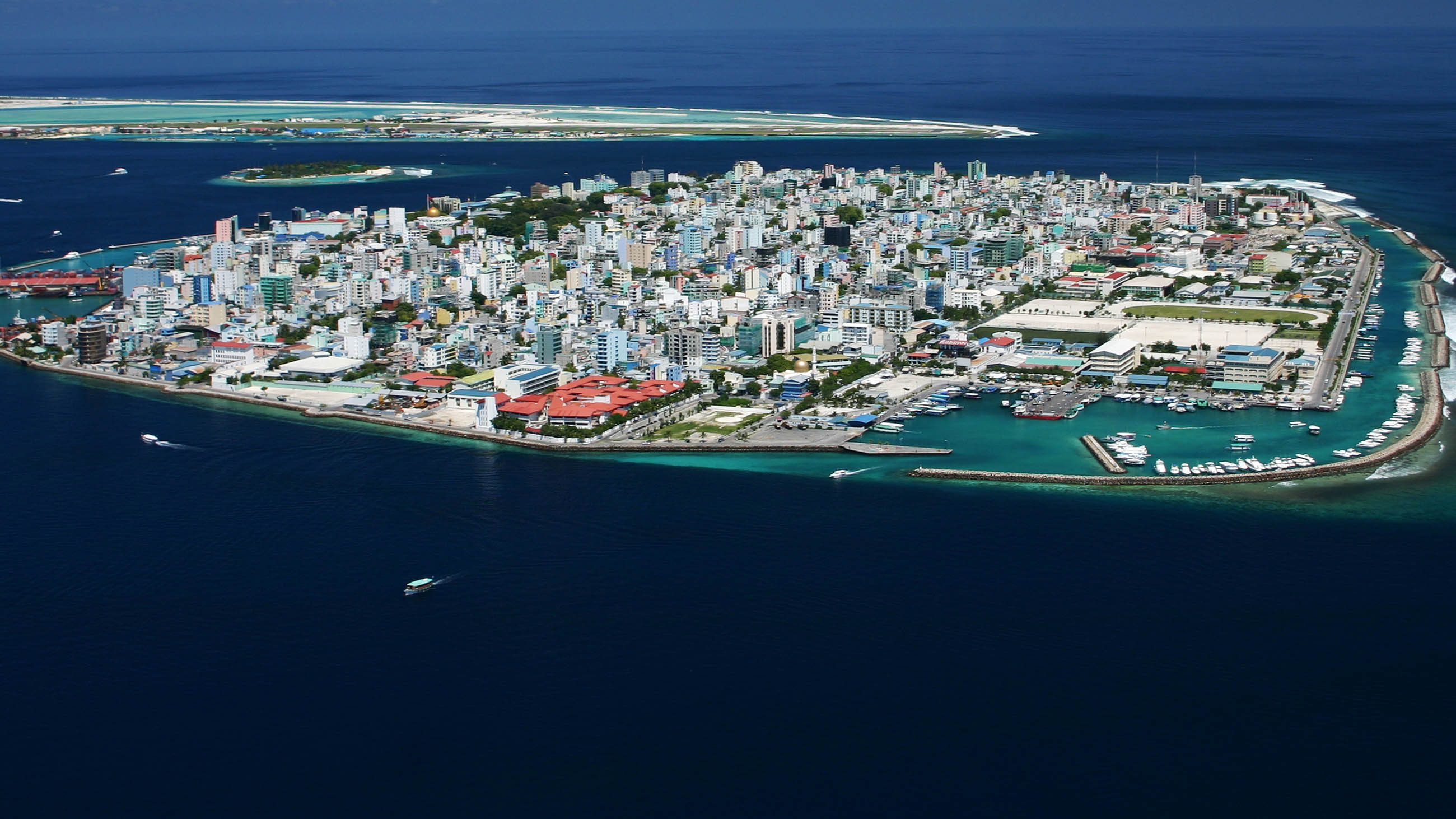Planning for the End
In 2014, the tiny, low-lying island nation of Kiribati acknowledged the uncomfortable truth that in the not-too-distant future, it might become the former tiny, low-lying island nation of Kiribati. The government purchased about eight square miles of land more than 1,000 miles away in Fiji, a country that boasts some higher elevations. The idea was simple: When left with no other option amid rising seas and devastating natural disasters, the entire population would pack up and move away.
To be sure, the world has already engaged in the morbid feting of the “first” climate refugees. That distinction has variably gone to subsets of populations from the Carteret Islands in Papua New Guinea, and another group from Tuvalu. The American media tends to focus on domestic firsts, though even here there are multiple contenders, with émigrés from coastal communities in both Louisiana and Alaska vying for the credit.
But no country, to date, has yet been forced from its territory entirely by climate change — though most low-lying island nations, from Nauru and the Solomon Islands to the Maldives, Tuvalu, and others, worry that time will come. With elevations rarely exceeding five or six feet above sea level, many of these countries have, like Kiribati, begun some of the preliminary departure planning.
Still, such reckoning raises some important questions: When, for example, should an exodus occur? At what point does staying put become untenable, and what factors should go into that decision? Will citizens willingly depart before disaster strikes, or must tragedy nudge the final evacuation? Turns out the answers to those questions are far from straightforward, and many island nations — for lack of resources and options — are likely to tough it out for as long as reasonably possible.
“Worst-case scenarios will no doubt play on the minds of many,” says Espen Ronneberg, a climate change advisor for the Secretariat of the Pacific Regional Environment Program, an intergovernmental organization devoted to sustainable development. Though discussions on mass migration have been “heated and at times emotional,” Ronnenberg said, no specific proposals to move away have been suggested so far, and issues ranging from legal sovereignty to social traditions will undoubtedly stand in the way.
Of course, the rate and magnitude of projected sea level rise has long been a contentious issue in climate science circles, but many stakeholders think official projections are too conservative. The Intergovernmental Panel on Climate Change’s most recent report pegged the high end of sea level rise at around one meter by 2100, though it also acknowledges the likelihood that the seas will continue to rise for many centuries beyond that point. A survey of 90 experts in 2014 nudged the seas even higher, with potentially 1.2 meters of increase by 2100, and as much as three meters in the two centuries after that.
Some recent studies have also suggested that Greenland’s and Antarctica’s ice sheets, which hold enough water to raise sea levels hundreds of feet, could collapse faster than previously thought possible. But even at the more modest rates of projected rise, many coastal areas — and certainly some island nations — could disappear.
Alongside sea level rise, decision makers must also consider future natural disasters. Though sea level rise may be felt incrementally over time, for many nations, it will likely be a cyclone or tsunami that forces an answer to the question: rebuild or abandon?
Obviously, predicting a major storm is a thoroughly inexact science. Models can suggest the likelihood of stronger storms in general, or changes in number of cyclones across specific ocean basins, but Tuvalu or the Solomon Islands cannot say with much certainty when a storm’s track will next pass over them. That uncertainty could engender complacence, even if logic dictates that moving before a disaster, rather than waiting until afterward, is more prudent.
Kiribati paid only about $9 million for its Fijian escape hatch. An evacuation without any pre-planned destination would cost a lot more.
Philip Haines, managing director of an Australian firm that helped with the logistics when an entire town in the Solomon Islands decided to take leave, says he expects that tolerance to extreme events will increase in the near term, “given the substantial barriers to relocation.”
Haines says the biggest of those barriers is land ownership, both in terms of personal connection to a territory that has been occupied for centuries, and the daunting task of finding suitable land elsewhere. That point was echoed by John Campbell, an associate professor in the Department of Geography, Tourism and Environmental Planning at New Zealand’s University of Waikato, in a paper on climate-related migration in the Pacific. “Throughout the region,” Campbell wrote, “the relationship between people and their land is often so strong that the two are considered inseparable.”
Ronneberg, who hails from the Marshall Islands, similarly describes “a sense of belonging that is very strong.”
Also difficult, Haines suggested: finances. “The next major challenge is funding the rebuilding exercise, especially for public infrastructure,” Haines said. That land in Fiji may have cost only $9 million, but the roads, houses, hospitals, schools, and everything else will cost a whole lot more. “Costs for building new towns and cities from scratch are enormous,” Haines said — noting that these countries are generally not rich.
On the World Bank’s list of 195 countries ranked by GDP, Tuvalu ranks dead last, just behind Kiribati, and the Marshall Islands. A $9 million relocation plot in Fiji would consume roughly a quarter of Tuvalu’s annual national output.
“Other countries around the world need to recognize the call for help and respond accordingly,” Haines says. “Experience suggests, though, that it will take a calamitous event for the message to be heard and for the global community to care.” Though the billions have started to add up in international climate-related aid, there are relatively few such dollars slated specifically to help a country pick-up and move.
Though he praised the concept of planning ahead and moving before disaster strikes, Keith Alverson, in charge of the UN Environment Program’s Climate Change Adaptation and Terrestrial Ecosystems Branch, agrees that migration will more likely be a reactive, than a proactive, maneuver. “I think the reality is that people won’t do it preventively,” he says. “It’s very rare that you get someone picking up, leaving their home, and saying I’m going to move because I’m worried about the future.” Just because Kiribati bought some land doesn’t necessarily mean they will use it under anything less than existentially dire circumstances.
One possible exception, Alverson suggested, is in cases where stakeholders create economic or other opportunities elsewhere, providing residents of climate-imperiled nations some incentive to leave their homes. “Our rationality doesn’t really cover this slow exodus, in a planned way, because climate change is occurring,” he says.
At the same time, Alverson doesn’t want to let residents of small island developing states, or SIDS, off the hook entirely, and suggests that they have some adaptation strategies at their disposal that could, at the very least, forestall the need for a sudden exodus. “These countries are over-populated by people and they’re killing off the natural resources that would protect these islands from sea level rise,” Alverson says. “That’s not a narrative that anyone likes to speak about in [the UN] because it sort of shares the blame.”
He points out that coral atolls, which are the basis of many of the island nations in question, can actually adapt to rising seas quite well. The corals — animals, after all — simply grow higher as the seas climb, and data from the last time seas rose rapidly, about 11,000 years ago, suggest the islands don’t simply fall beneath the waves. There are data to support this in the modern era as well: A study in 2015 in the Funafuti Atoll showed that the islands have recently increased in land area as the seas rose around them.
Of course, rising ocean temperatures and acidification threaten the corals’ very existence. And in any case, the infrastructure that humans create won’t simply rise up along with the reef — just look at aerial photos of Malé, the capital of the Maldives, to get an idea — suggesting that inundation remains a likely scenario. Data supports Alverson’s point: In 1968, 22.2 percent of Kiribati’s population lived in an urban area, but by 2008 that had jumped to 46.3 percent. Tuvalu’s urban population made up 14.3 percent of the total in the 1960s, and over 51 percent by 2008. In Kiribati, the country’s total population doubled over that period.
Though Alverson fully acknowledges that the islands have done almost nothing to contribute to climate change and sea level rise themselves, he argues that in many ways, they already have some solutions available. “Sometimes the best way to deal with the problem is to look at the natural resilience of ecosystems and preserve them. That’s a great adaptation strategy, and that strategy is for the most part being ignored by a lot of these SIDS.”
The IPCC’s chapter on small islands features much discussion of adaptation, but only briefly touches on migration as a strategy. Part of the reason for this, the report notes, is that, as of yet, there is no evidence of any nations actually engaging in a mass abandonment of their territories. But the authors also say that “financial and legal barriers are expected to inhibit significant levels of international environmentally induced migration in the Pacific.”
In the end, this may require a much more aggressive focus on building resiliency and population management, rather than a yes-no vote on leaving the island behind. “Maybe that same island in Kiribati would be fine with a small population, but with a big population they’re not going to be fine,” Alverson says. “How that all maps out in reality, with people deciding to leave, or not deciding to leave, is a very complicated thing.
“It would be simplistic to believe,” he added, “that the government could just say ‘Okay, we bought that land, everybody move. Start over.’”
Dave Levitan is a freelance journalist based in Philadelphia who writes about energy, the environment, and health. He is the author of the forthcoming book “Not A Scientist: How Politicians Mistake, Misrepresent, and Utterly Mangle Science.”










